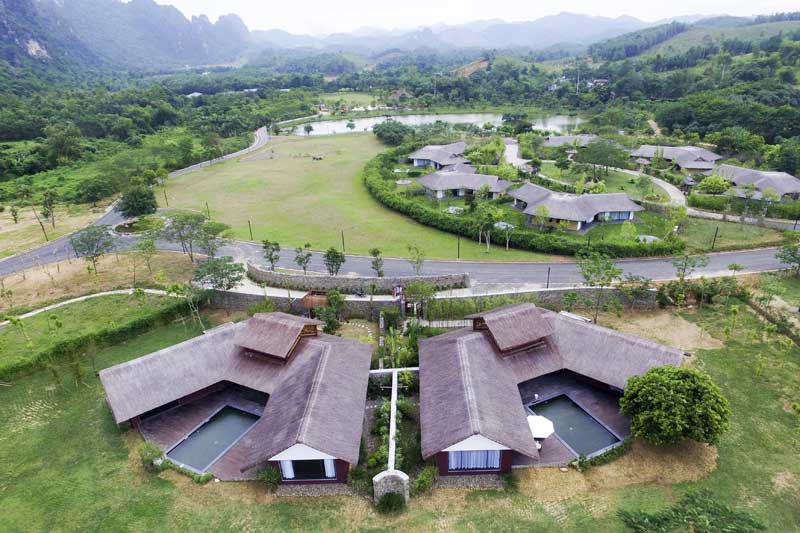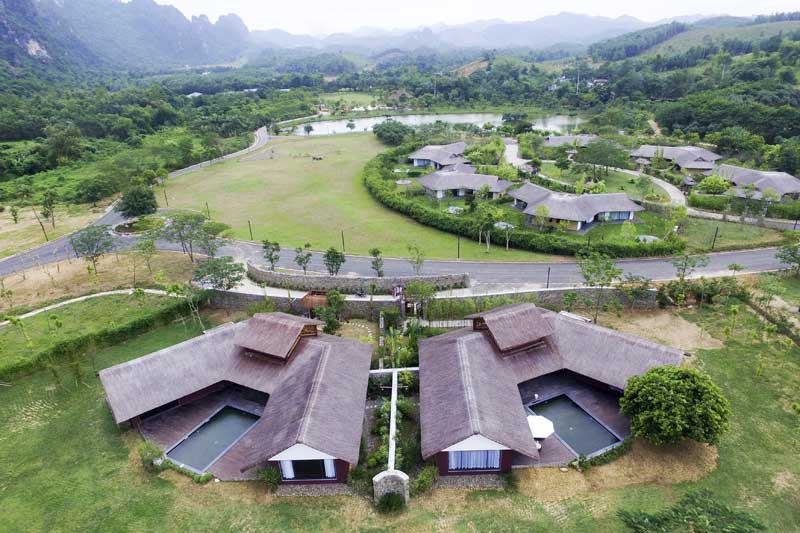
(HBO) – Kim Boi district in northern Hoa Binh province is endowed with beautiful natural scenery with majestic caves, mountains and forests. It is also famous for folk culture and traditional festivals of Muong ethnic minority group. To promote its potential, the district has focused investment on improving the quality of tourism services, striving to become a high-quality tourism centre in the province.

Serena Resort in Khai Doi hamlet, Sao Bay commune, is one of
the high-class resorts in Kim Boi district.
Kim Boi has long been known for its hot mineral
spring. The spring is considered one of the best natural mineral
hot springs in
Southeast Asia.
Additionally, Kim Boi is a famous land of folk culture and traditional
festivals of the Muong ethnic minority people. Archaeological relic site of
Dong Thech ancient tomb (Chieng hamlet, Vinh Dong commune) dating back to the
second half of the 17th century with small and big stone columns carved in Han
– Nom scripts was recognised as a national relic site. Annually, a number of
festivals are held across the district such as Muong Dong festival (to pray for
good crops and happy families), spring festival, Khuong mua (xuong dong or
taking to the paddy fields), and a festival celebrating a new rice crop. Folk
community games are held at village festivals such as ‘nem con’ (cloth balls
throwing), ‘keo co’ (tug of war), and ‘day gay’ (stick pushing) along with
unique dances.
Furthermore, Kim Boi boasts a diverse system of
caves, mountains and old forests. These natural advantages enable the district
to develop eco-tourism, resort tourism and tours to explore Muong ethnic
culture. The district is home to many eco-tourism sites such as Serena Resort (
Sao
Baycommune), Cuu Thac Tu Son (site of nine waterfalls in Tu Son commune), Mat Troi
(Sun waterfall in Kim Tien commune), Thuong Tien specialised forest and
V’Resort (Vinh Tien commune).
The
number of visitors to Kim Boi district is higher than those to the districts of
Ky Son, Yen Thuy, Luong Son, Lac Son, Tan Lac and Cao Phong. However, the
figure is lower than those of Hoa Binh city, and Mai Chau and Lac Thuy districts.
Kim Boi district ranked third in the province in terms of revenues from tourism
services last year with 137.6 billion VND (6 million USD), just behind Luong
Son and Lac Thuy districts. Last year, the district’s tourism sector saw
promising signals. By the end of November, Kim Boi welcomed nearly 197,000
tourists, including 18,771 domestic visitors and 8,124 foreigners. Hotel room
occupancy reached 65 percent.
The district is planning to develop high-quality tourism to attract more
domestic and international foreigners. High-end resorts will be developed in
parallel with top quality tours and community-based tourism. It expects to welcome
250,000 visitors by 2020, 400,000 by 2025 and 650,000 by 2030. Earnings from
tourism are expected at 250 billion VND by 2020, 460 billion VND by 2025 and
900 billion VND by 2030./.
Located just a 20-minute drive from Hoa Binh City, Ora Hill Farmstay & Glamping Hoa Binh is a captivating new destination nestled in Mo hamlet, Bình Thanh commune, Cao Phong district. Combining farming with leisure, this tranquil retreat is perfect for those seeking balance, joy, and an immersive experience in the expansive beauty of nature.
Muong Bi - Tan Lac is renowned as one of the four famous Muong regions in Hoa Binh province. Blessed by nature with a favourable climate and stunning landscapes, Tan Lac holds great advantages for tourism development. The local tourism industry has made remarkable strides in recent times thanks to the attention and support from the local authorities and sectors.
With its strategic location, well-developed transport network, and diverse soil and climatic conditions, Hoa Binh is emerging as a must-visit destination in Vietnam's northwestern tourism corridor. The province boasts numerous attractions, including the Kim Boi hot springs (Kim Boi district), the Dau Rong cave complex (Cao Phong), the Mai Chau valley (Mai Chau), and the iconic Hoa Binh hydropower plant.
The northern mountainous province of Hoa Binh has been listed among the 71 most beautiful places to visit worldwide by the prestigious US travel magazine Condé Nast Traveller.
Hoa Binh province’s rich natural and cultural resources position it as a prime location for developing community-based tourism (CBT). In recent years, support from central and provincial policies, as well as assistance from non-governmental organisations, have encouraged local ethnic minority and mountainous communities to actively engage in the sector.



